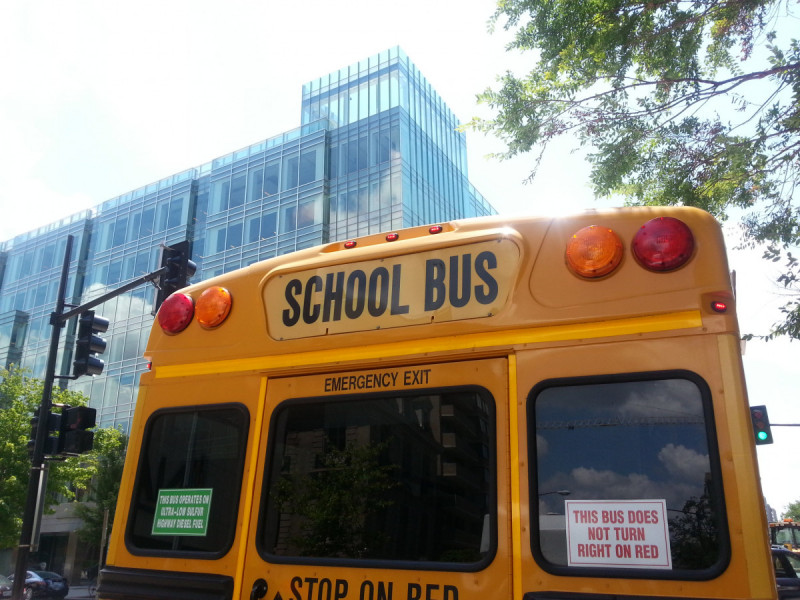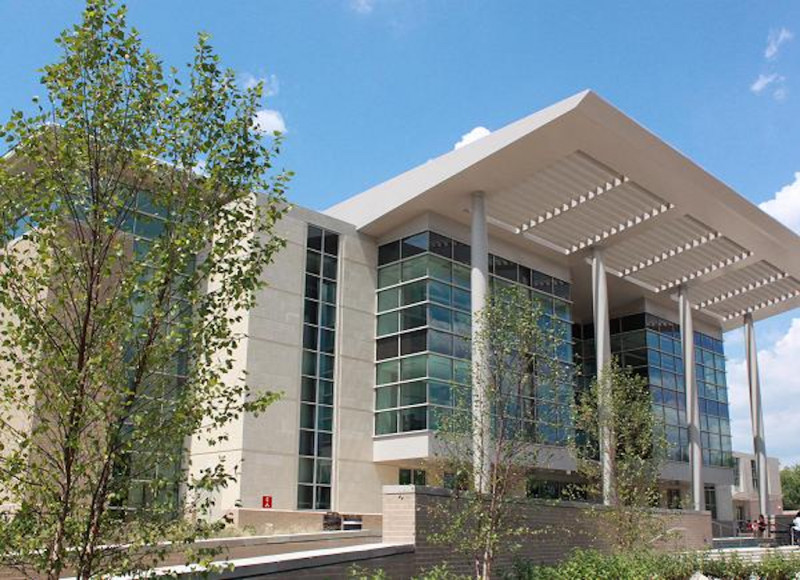What experts say needs to be done to disrupt historic patterns of segregation in DC’s schools

Students walking on steps stock photo from Shutterstock.
This article is part of a limited series exploring the history, current policies, and intersections between school boundaries and feeder patterns in DC’s public schools and land use, housing, and transportation issues. Read Part I, Part II, and Part III. And then learn more by tuning into the series’ companion webinar, moderated by journalist Abigail Higgins.
When Washington DC last redrew its school boundaries in 2014, parts of the city were roiled by protest. It was led with particular gusto by some of the city’s higher-income parents from Northwest neighborhoods who had purchased pricey homes based, in part, on the school boundaries they were situated within.
It wasn’t the only education debate gripping the city at the time: Tensions were already high as one-tenth of DC public schools were slated to close as part of a plan to shutter under-enrolled campuses as charter schools proliferated across the city. It was not lost on many parents that these schools were located entirely in the city’s lower-income neighborhoods east of Rock Creek Park and east of the Anacostia River.
The city was grappling with questions not dissimilar to those of cities across the United States, a country where Black and white students are more segregated today than they were during the Civil Rights movement. DC continues to grapple with these questions today: Should the city focus on choice, allowing students to attend a variety of schools across the city, or invest in neighborhood schools, where kids go to whatever school their address assigns them to — or should the city land somewhere in between these two poles?
DC’s current lottery system falls in the last category, which allows every student to either attend their in-boundary neighborhood school, or enter the My School DC lottery in which families can rank their top 12 public and charter schools after which an algorithm assigns them a spot.
DC hasn’t redistricted since those heated debates leading up to 2014. When the city finally does again, many education experts are wondering how to avoid the same bitter debates — and whether DC’s current system is the best one.
In the last piece in our series about the ways that school boundaries impact inequality in housing and transportation in DC, Greater Greater Washington explores some of the ways education experts say DC can better serve its students.
A DCPS school bus circa 2014. Image by Ryan McKnight licensed under Creative Commons.
Regular redistricting
About a quarter of DC students stay within their school boundaries, which means that one step is examining these lines.
“If you’re gonna have a school choice system with lotteries that’s fine but if you have a map under the hood, it should be a map that’s fair,” said Tomás E. Monarrez, a senior research associate at the Urban Institute and one of the authors of a reporton the ways that contemporary school boundaries reflect the historic redlining maps meant to keep Black families out of certain neighborhoods.
Monarrez adds that in many cities relatively small tweaks to school boundary lines can have a significant impact on integrating schools.
Some advocates also say these boundaries should be reviewed on a standardized timeline, the need for which at-large Councilmember Christina Henderson highlights in her Attendance Zone Boundaries Amendment Act of 2022(under which it would next occur in 2024).
“It’s going to be an emotionally charged conversation and if we do it systematically then hopefully we can take some of that out of it,” said Henderson, who believes a well-designed, data-driven analysis will be crucial.
Some advocates also suggest efforts to explicitly delink housing purchases from education, such as a bill in Montgomery County that would require people to sign a paper acknowledging that school boundaries are mutable before buying a house.
“It becomes way less fraught when people know to anticipate it,” said Dan Reed, GGWash’s regional policy director.
Students Attend a Walk to School Day Pep Rally Image by DDOT DC licensed under Creative Commons.
Prioritizing “at-risk” students
The fact that the majority of DC students will not go to their neighborhood school, however, means that school boundaries are only one part of the solution.
DC’s lottery system is fairly unique, both because it combines charter and public schools and because it’s centralized. Implemented in 2015, it replaced a complicated and often chaotic system where parents had to navigate the lotteries and applications of dozens of individual schools.
Still, DC schools continue to struggle to disrupt historic patterns of segregation. While students are fairly likely to go to school with students of a different class, they’re much less likely to go to school with a lot of students of a different race.
One way to improve the lottery for “at-risk” students, some advocates say, is to give at-risk students (including students experiencing homelessness, students in the foster care system, and those receiving government cash or food assistance) a priority.
Currently, at-risk students are less likely to get into their school of choice, both as a result of long waitlists in highly sought-after schools and because sibling priority in the lottery means that current school demographics are hard to disrupt.
While a 2018 study found that giving at-risk students a higher priority would improve outcomes for just 8.2% of at-risk participants, a 2020 study by DC Policy Center was much more promising.
They looked specifically at charter schools with long waitlists that had just 15% of at-risk students enrolled (city-wide, 45% of students are at-risk). At these schools, given the preference siblings get in the lottery, it was hard for at-risk students to snag a coveted spot.
They found that giving them an edge in the lottery, even less of one than the sibling priority, could increase their match rates from 4% to 42%.
This program is already being piloted. In 2022, eleven charter schools started giving lottery preference to at-risk students, which a 2021 DC Council bill paved the way for. Given that the at-risk population encompasses almost half of the city’s students, however, this program would likely need to be significantly expanded to have widespread impact.
HD Woodson High School, Washington, DC. Image by the author.
Invest in under-enrolled schools
Another potential solution is to invest in under-resourced schools or neighborhoods, whether by putting magnet schools (perhaps with specialized STEM programming or language immersion) into low-income neighborhoods or adding specialized programming to under-enrolled schools, such as a Montessori program.
A $127 million renovation at Petworth’s chronically underperforming Roosevelt high school, which included a Spanish language program and an Olympic-sized swimming pool, is one example of an attempt by DCPS to make the school more attractive for neighborhood parents.
One problem with attracting parents to schools, however, is that the way to measure what makes a “good school” is pretty subjective — and often biased. Many evaluations of schools rely heavily on test scores, for example, which research shows dips for poor students during the last two weeks of their food stamp benefits and can be affected by neighborhood violence.
“It is so hard to get people who listen to blogs, who go off word of mouth, to actually go into a building and see for themselves that what the school was like 20 years ago is different than what the school is like today,” said Henderson of fighting historic stereotypes about DC schools.
On September 20, 2022, GGWash hosted webinar, moderated by journalist Abigail Higgins, based on this story series. Watch the recording to learn more about the topics raised in this article.
Making streets and commutes safer for students
Oversight over school boundaries and reinvesting in under-enrolled schools may be part of the solution. But how can the District also improve upon the travel patterns and commutes for students as well? As reported earlier, students travel an average of more than two miles each way to get to school. Long commutes and unreliable transportation play a part in school attendance.
Some measures like the Kids Ride Free program have been implemented to provide more resources for students and their parents to get to school. And better resourced neighborhood schools could cut down on commute time for many students. However, that does not address other dangers for students as they navigate to school.
DC has made moves like expanding the District’s Safe Passage program, which would hire adults to help students travel safely in areas that have high rates of crime, according to reporting from the Washington Post. Students have also been particularly vulnerable to traffic violence in the District. And advocates have long connected the dots between violence on our roads and in our communities. The District Department of Transportation (DDOT) recently reduced the speed limit on some major streets from 30 mph to 25 mph. There is also legislation like the Safe Routes to School Expansion Regulation Amendment Act that beefs up safety infrastructure around schools.
A tough but worthy fight
Figuring out the answers to these thorny questions, or at least continuing to iterate in the face of them, will be one of the most vital questions facing the city in upcoming years.
For one, because it’s good for kids: when a student body is economically and racially mixed there are a host of academic benefits, found a large study from the Century Foundation, ranging from higher college enrollment, to better test scores, to reduced racial achievement gaps.
There are also social benefits to diverse schools, the study found, reducing racial bias, improving leadership skills, and making students more likely to seek out diverse communities later in life — which is among the reasons that making the city’s schools more diverse and equitable is a fight every resident should care about.
This article is part of a limited series made possible with a grant from Education Forward DC. Greater Greater Washington’s editorial department maintains editorial control and independence in accordance with our editorial policy. Our journalists follow the ethics guidelines of the Society of Professional Journalists.
